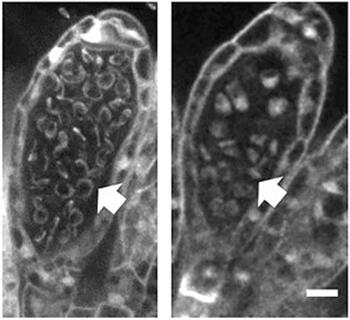Through international joint research with Professor Mitsuyasu Hasebe of the National Institute for Basic Biology and Professor Chen Chun-ri of the Huazhong Agricultural University, the research group of Associate Professor Yosuke Tamada, and Research Fellow of the Japan Society for the Promotion of Science, Gu Nan, of Utsunomiya University Academy found that the enzyme DNA topoisomerase 1 (TOP1), which unstrains the DNA double helix structure, plays an important role in normal sperm formation in the bryophyte Physcomitrella patens.
The research group extensively observed the spermatogenic process in Physcomitrella patens by bioimaging and performing three-dimensional image analysis. As a result, it was clarified that the volume of the spherical cell nucleus, in which the DNA is present, synchronously decreases in the process of spermatogenesis, converting into a string-like cell nucleus. It was suggested that this string-like sperm cell nucleus is essential for forming a compact sperm body, which facilitates swimming in a liquid, such as water, to reach the egg cell. Furthermore, it was found that this synchronous shrinkage of the nucleus did not occur in Physcomitrella patens without the TOP1 gene.
This resulted in a marked reduction in fertilization efficiency, with only a small fraction of spermatozoa showing string-like cell nuclei, whereas most spermatozoa had spherical or incompletely contracted cell nuclei, even at the stage when the spermatozoa were released. In addition, it was indicated that TOP1 functions in the contraction of the spermatid nucleus during the spermatogenesis process of animals; however, the underlying mechanisms remain unclear. Several studies have led to the discovery of common spermatogenic mechanisms in plants and animals, and further allowed the group to clarify the functions of TOP1 during plant spermatogenesis. This finding is expected to contribute to clarifying the mechanism of formation of compact spermatid nuclei common to animals and plants, as well as to elucidating the male sterility mechanism of plants and animals.
"In addition to investigating how TOP1 functions in the shrinkage of the spermatid nucleus," Professor Tamada stated that, "I wish to work with animal and plant spermatozoa and spermatid researchers to clarify the mechanisms of male sterility in plants and animals, including humans."

Provided by Utsunomiya University
This article has been translated by JST with permission from The Science News Ltd.(https://sci-news.co.jp/). Unauthorized reproduction of the article and photographs is prohibited.




